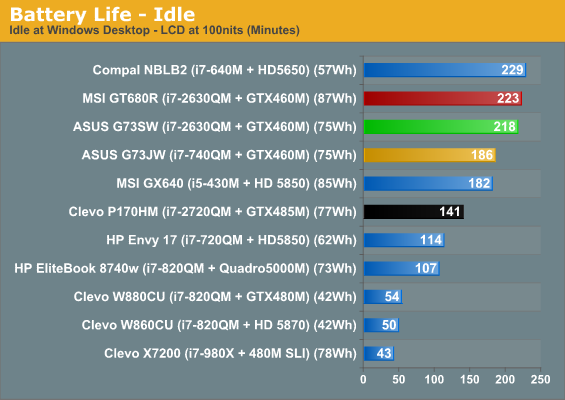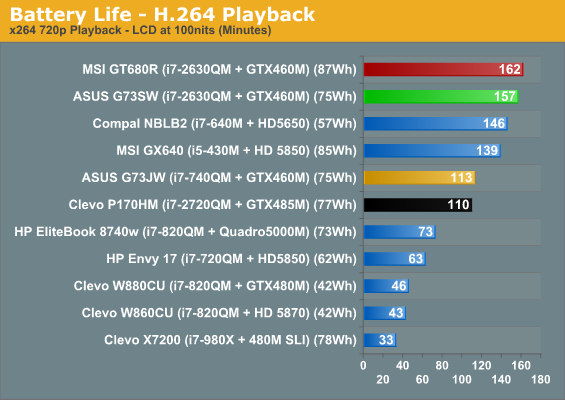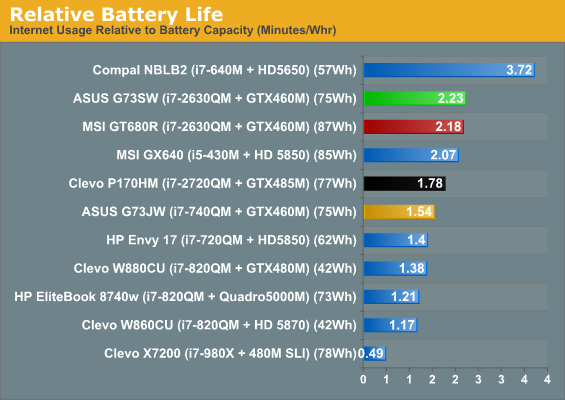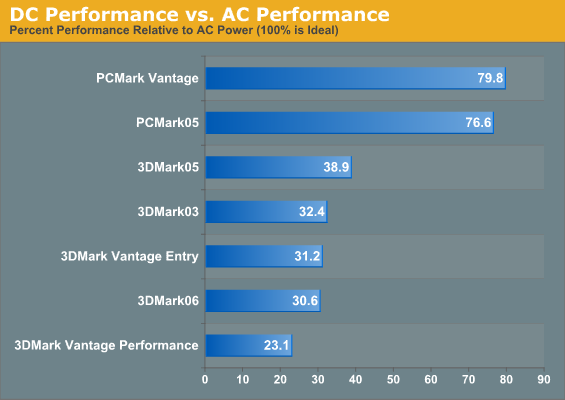ASUS G73SW + SNB: Third Time’s the Charm?
by Jarred Walton on March 4, 2011 12:00 AM ESTBattery Life
The G73 is a 17.3” notebook chassis with a 75Wh battery; we know what that means, right? You’re not going to get all-day computing, or even half a day (unless you have a six-hour workday). We also know that Sandy Bridge is more power efficient than Clarksfield, so we should see some gains relative to the G73JW. And that’s exactly what we get.




Idle battery life is up 17% to 3.75 hours, and that’s the smallest increase. Internet battery life is up 27%, though it falls just shy of the three-hour mark, and H.264 decoding is up 39% to over 2.5 hours. While those are all fairly impressive increases over the previous generation, let’s not lose sight of what we could get with switchable graphics. A vanilla i7-2820QM notebook running off the HD 3000 IGP manages roughly double the runtime in our battery life testing, and that’s with a slightly smaller battery.
We can actually estimate the idle power requirements of the GTX 460M based off of those results, and let me tell ya, it ain’t pretty. Based on the 71Wh battery and the various test results, the Compal SNB notebook we tested used an average of 9.04W at idle, 10.24W in the Internet test, and 16.38W in H.264 playback. In comparison, the G73SW averages 20.64W idle, 26.95W Internet, and 28.66W in H.264 decoding. That means the GTX 460M requires roughly 10W at idle with very low clocks (50MHz core, 270MHz RAM), around 15W with a web browser showing Flash advertisements, and the difference between HD 3000 and GTX 460M in H.264 encoding is back to ~10W. Sadly, these high-power GPUs just aren’t very friendly to battery life, with just the GPU using about as much power as the rest of the notebook combined. Here’s where NVIDIA’s Optimus Technology would have been useful: twice the battery life, the ability to use Intel’s QuickSync technology, and discrete graphics performance when you want it.
Plugged in power numbrs are all higher, as the GPU isn't in "limp mode" and we also ran the LCD at maximum brightness. At idle, we measured 27W at the outlet using a Kill-A-Watt device; taking into account power adapter inefficiency, that figure matches up pretty well with our above calculation. When we put a 100% load on just the CPU (using Cinebench 11.5 SMP), power draw gets as high as 87W. Running through the various 3DMark tests, we saw a maximum "typical gaming" load of 114W, whereas Furmark manages to push the GPU just a little harder and we measured up to 125W. It's also interesting to note that we couldn't get power draw any higher by running Furmark with a CPU loading utility; the CPU load was apparently enough to reduce Furmark performance and so our "worst-case" CPU+GPU load actually dropped to 118W. Again, factoring in power adapter inefficiencies, there's still plenty of headroom on the 150W power brick (unlike the 300W brick in the Clevo X7200 with SLI systems), so you can even play games while charging the battery.
We've had some reader requests for a few other battery life metrics. Charging time on the G73SW (with the system powered up) checked in at 168 minutes; it might recharge slightly faster if the system is off, but with a 150W power brick there should be plenty of extra juice for the charging circuit. If you want to run the LCD at maximum brightness rather than 100 nits (or cd/m2 if you prefer), idle battery life drops to 195 minutes. So the extra 55 nits of brightness requires an additional ~2.5W of power. We also ran our Internet test with Pandora open and streaming music in a separate browser tab; that dropped battery life down to 140 minutes. Finally, what about gaming on battery? With the GPU set for maximum performance, we managed 67 minutes looping 3DMark06, but there’s still a catch.
Even trying our best to achieve maximum gaming performance while on battery power, the GPU is still throttled—and the CPU appears somewhat slower as well. We ran the full Futuremark test suite on battery power, using the High Performance power profile. The following chart shows the percent of performance relative to the same test running off the mains (so a score of 100 would be no change in performance).

The best results are in PCMark, where battery performance is still 80% of plugged-in performance. Move over to graphics tests, and 3DMark05 managed to maintain nearly 40% of AC performance, 03/05/Vantage Entry are in the range of 30-32% of AC performance, and the Vantage Performance preset is less than one fourth as fast. To put that in perspective, you’re looking at gaming performance that’s actually worse than what you’d get with a midrange GT 425M GPU.
The problem appears to be getting sufficient power to the GPU from the battery for the higher clocks, as the midrange GPUs don’t forcibly throttle performance on battery power (at least in my experience). Then again, it’s not like you get significantly better battery life for gaming on a midrange GPU—I measured 104 minutes with a GT 425M on an 84Wh battery with an i3-380M CPU and a 14” chassis. In other words, while it’s possible to have a gaming laptop that gets good battery life (i.e. by shutting off the GPU), unless something changes in a big way we’re not going to get great gaming performance while on battery power. So fire up your smartphone and play some Angry Birds instead :)










56 Comments
View All Comments
parthgh - Friday, March 4, 2011 - link
" So far, no one has been willing to try NVIDIA’s Optimus Technology with any mobile GPU faster than the GT 435M, although we hear there’s a GT 555M Optimus notebook coming some time in 1H’11."I guess XPS 17 has already launched and has Optimus enabled (apart from the 3D version).
Also the XPS 17 before SB revision had GT 445M with optimus enabled.
JarredWalton - Friday, March 4, 2011 - link
Still not faster than 460M... I didn't realize Dell upped the XPS 17 to the GT 555M, though. Interesting, and something I'll try to get them to send me now. Thank goodness they're now doing Optimus on all GPUs!Someone above asked about how they compare in performance, though. 460M has 192 cores at 675MHz with 2500MHz (effective) RAM. 555M has 144 cores at 590MHz with 1800MHz (effective) RAM. Note that 460M uses GDDR5 by default where the 555M goes with DDR3 by default. So the net result is 460M has 52.5% more computational power and 38.9% more memory bandwidth. I'd say GT 555M will be good for medium detail at 1080p, or high detail at 900p (give or take).
Drooosh - Saturday, March 5, 2011 - link
FYI - They won't allow you to get the good 1080P screen with Optimus. For some reason if you get the 1080P screen they force you to have it configured for 3D/120Hz which requires the 555M be enabled full time and thus no Optimus.I would bet that most customers are like me and would prefer Optimus over 3D. If they gave me FHD, 555M, and Optimus, I would by now.
Jarred, do you know of anyone that will have 555M or better switchable graphics, 1080P, and a backlit keyboard in a 15 or 17"? Lenovo or MSI may have thiese soon it appears?
JarredWalton - Saturday, March 5, 2011 - link
Right now, I'm not aware of anything like that. I don't know why Dell insists on doing weird things like killing Optimus support with certain upgrades. Perhaps Optimus doesn't work quite right with 3D at present? Heck, I'd just as soon skip all the 3D notebooks--the 120Hz panel is fine, but 3D just doesn't do anything for me.I've asked my NVIDIA contacts if there are any current/upcoming laptops with your above feature list. I've also asked them why no one appears to be willing to use Optimus with 460M or better. We'll see if they respond with any useful information. :-)
bennyg - Monday, March 7, 2011 - link
I heard rumours it's the way Optimus works sending the data from GPU to onboard gfx, the sheer amount of data pushed from high-end GPU to iGPU saturates that link, so midrange is OK but high-end suffers bigtime performance issuesIt does seem ridiculous that every SB laptop has the hardware to run ridiculous battery life (sans GPU of course) but not the drivers to allow it.
I don't care about Optimus and profiles. Give me a switch or a combo box and that will be better since I'll be in control not some numbskill algorithm. Just give me switching already!!!
strikeback03 - Friday, March 4, 2011 - link
In the Futuremark 3DMark Vantage Performance Score table on page 2 you have the wrong MSI laptop highlighted red.In the previous reviews I somehow missed how massive this laptop is, this time I noticed what a small portion of the chassis the 75WHr battery takes.
JarredWalton - Friday, March 4, 2011 - link
Thanks - the 3DMark Vantage chart is now correct. Also, I've added two more pictures to the gallery, this time with a tape measure in place. You can see the diagonal of the G73 chassis is about 20 inches (in a 17.3"-screen chassis...), and the Compal SNB unit we looked at in December also has a 17.3" LCD but the chassis is almost an inch smaller on the diagonal (and it's still got a lot of extra room for the large hinge). I'd like to see a 17.3" LCD in a chassis that's no more than 18.5", but I doubt that will happen.NaterGator - Friday, March 4, 2011 - link
As a G73SW owner I can absolutely 100% promise you this thing does not have an eSATA port anywhere to be found.Look over the unit they sent you again, but in the production unit I got from Amazon over a month ago there is most assuredly no eSATA. It is the only thing that frustrates me about this laptop, but the USB3.0 port makes up for it.
NaterGator - Friday, March 4, 2011 - link
Also, the screen flickering issue is a known bug with the nVidia drivers.Downgrade them to a 265 version and the flickering will stop.
JarredWalton - Friday, March 4, 2011 - link
I don't have that flickering problem on any other NVIDIA based laptops, though. Maybe it's localized to the G73SW for some reason? Anyway, you're correct about eSATA. Sorry for the error.